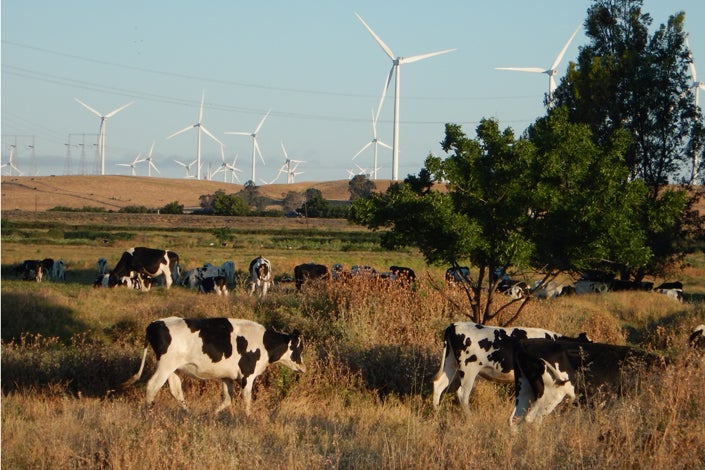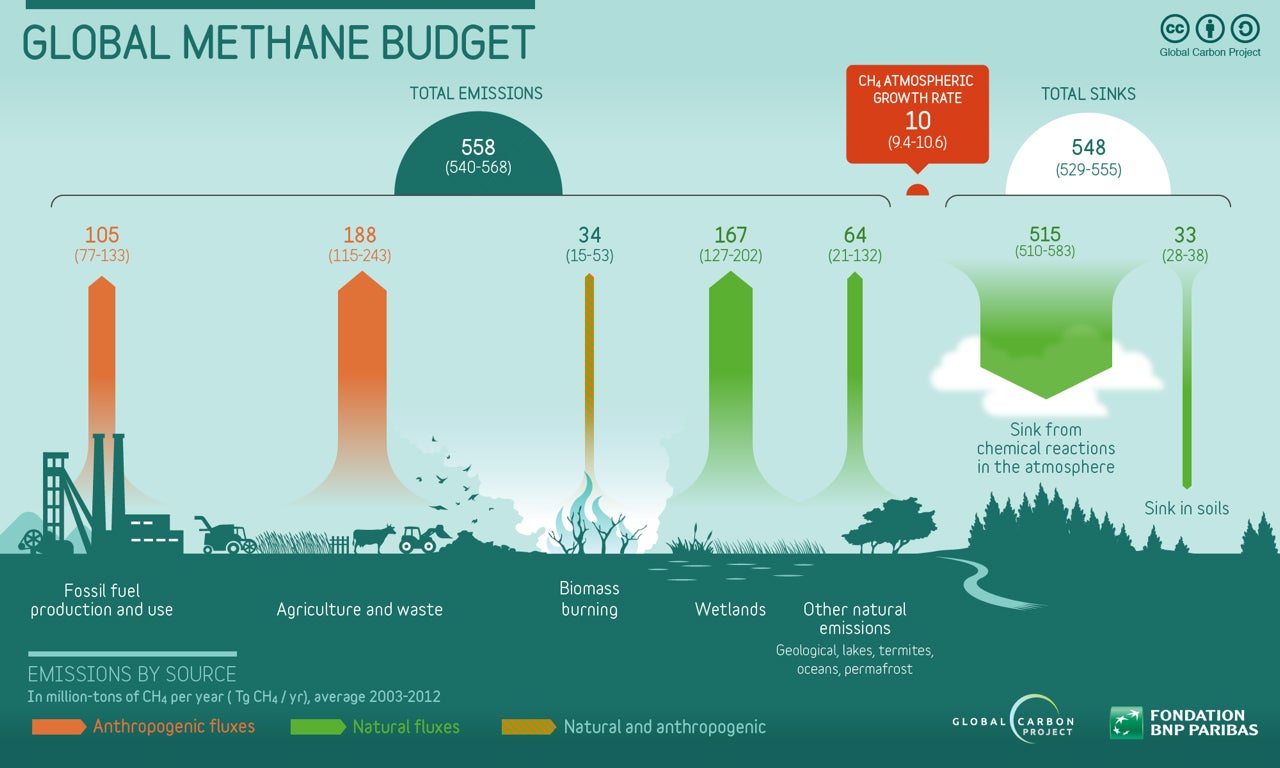A major opportunity for avoiding climate change’s worst impacts lies in reducing methane emissions, particularly from food production, according to a pair of new studies.

Cattle, which emit methane through bodily functions and manure, are among the reasons agriculture is the largest contributor to global methane emissions, according to a new study. (Image credit: Rob Jackson)
The parallel papers, published Dec. 12 in the journals Earth System Science Data and Environmental Research Letters, report that emissions of methane have jumped dramatically in recent years and are approaching an internationally recognized worst-case scenario for greenhouse gas emissions. Unchecked, this increase could see temperatures rise as much as 6 degrees Fahrenheit (4 degrees Celsius), speeding sea level rise and more extreme weather.
The papers also lay out recommendations for curbing methane emissions in the future, with a focus on food production, which makes up about one third of total man-made emissions. The papers were co-authored by Rob Jackson, chair of Stanford’s Earth System Science Department and head of the Global Carbon Project, which organized the work.
The alarming increase in methane draws attention to managing those emissions for climate change mitigation. While most mitigation efforts have focused on carbon dioxide, the more common greenhouse gas, methane’s warming potential is about 28 times greater on a 100-year horizon, and its lifespan in the atmosphere is much shorter. In other words, it can do major damage, but getting it under control could tip the climate change equation relatively rapidly.
“Methane presents the best opportunity to slow climate change quickly,” said Jackson. “Carbon dioxide has a longer reach, but methane strikes faster.”
The study comes in the wake of congressional Republicans’ stated intentions to rescind methane-limiting standards for the natural gas industry.
Surprising findings
The paper’s findings are particularly surprising because methane concentrations were stagnant for years up until a decade ago. And unlike carbon dioxide, the bulk of methane emissions are human-driven. Chief among those, according to the analysis, are agricultural sources such as livestock, which emit methane through bodily functions and manure, and rice fields, which emit methane when flooded. People are responsible for 60 percent of all methane emissions globally.
Despite a boom in U.S. oil and gas production, the study’s authors see rising fossil fuel emissions playing a secondary role compared to agriculture for the global methane increase. There is a lesson to learn, Jackson said. “The fossil fuel industry has received most of the attention in recent years. Agricultural emissions need similar scrutiny.”

Image credit: Global Carbon Project
Reducing uncertainties
Natural sources of methane, which account for 40 percent of all methane emissions, are more uncertain than human-driven ones. Examples include methane leaking out of natural faults and seeping on the ocean floor, and the potential for increased emissions as permafrost warms. Another research area includes studying the short-lived radicals that destroy methane in the atmosphere.
Because of the evolving nature of this knowledge, the international group of scientists behind the study plans to update the methane budget every two years. The effort is under the umbrella of the Global Carbon Project, an initiative headed by Jackson that releases an annual global carbon budget. The group’s most recent carbon budget shows concentrations of carbon dioxide have been largely flat for the past three years – a finding that reinforces the importance of methane management.
Working toward solutions
To resolve discrepancies on the magnitude of emissions and regional trends, Jackson and his co-authors recommend more accurate partitioning of methane emissions and sinks by region and process and more interactions among scientific groups developing emissions inventories.
Possible solutions for agriculture include breeding rice to require less flooding, altering feed for livestock to lessen intestinal processes that create methane, promoting less meat-intensive diets and deploying more farm bio-digesters. Opportunities in other areas include venting and flaring of methane in coal mines, detecting and removing natural gas leaks from oil and gas drilling operations and covering landfills to capture methane emissions.
In the meantime, the authors call for urgent attention to quantify and reduce methane emissions, stressing mitigation’s rapid climate benefits and economic, health and agricultural co-benefits. Jackson says, “We still need to cut carbon dioxide emissions, but cutting methane provides complementary benefits for climate, economies and human health.”
Jackson and colleagues received a recent grant from the Gordon and Betty Moore Foundation to further analyze global methane emissions and sinks.
Jackson is a senior fellow at the Stanford Woods Institute for the Environment and the Precourt Institute for Energy.
Media Contacts
Robert Jackson, School of Earth, Energy & Environmental Sciences: (650) 497-5841, rob.jackson@stanford.edu
Rob Jordan, Stanford Woods Institute for the Environment: (650) 721-1881, rjordan@stanford.edu